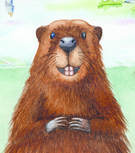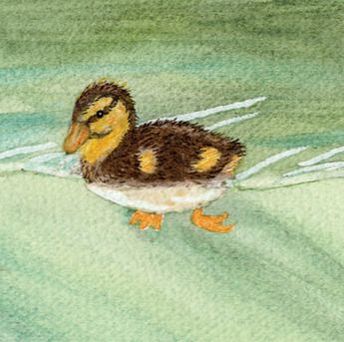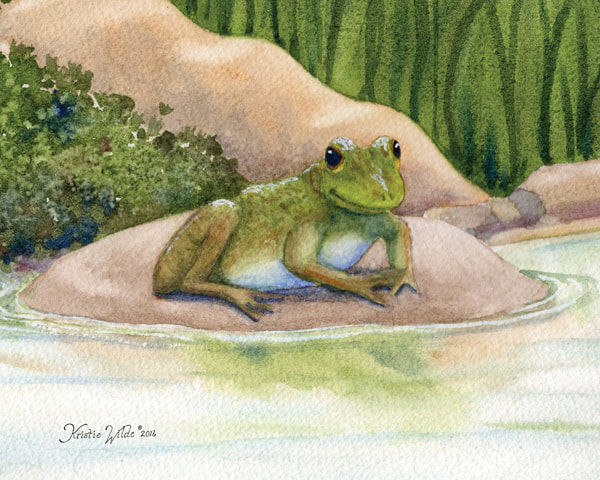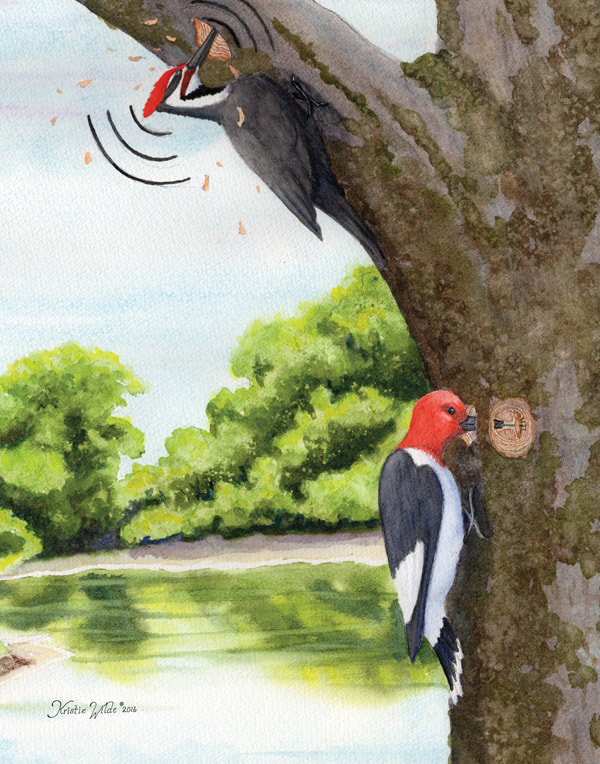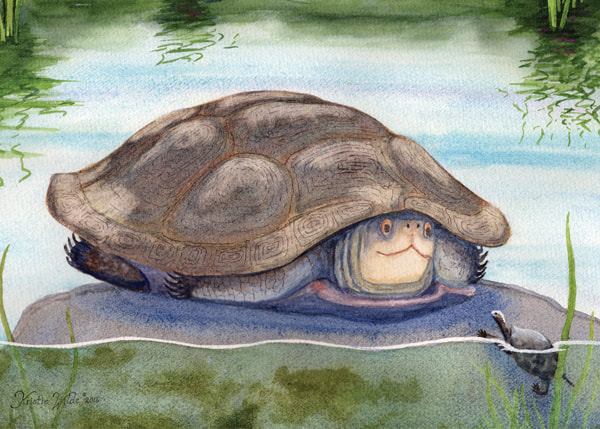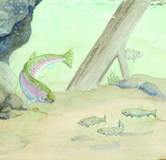This page is designed as a support resource for parents, grandparents and anyone wanting to introduce children to
the God of All Creation.
the God of All Creation.
Resources
My goal in producing the Joyful Creation series is to make clear God's hand print throughout this amazing world.
I write and illustrate with the intention of pulling back the veil, and revealing the Author of Life. I believe young children can comprehend and marvel at God's great wisdom and design when it's made plain to them. My purpose is to inspire them to appreciate the God of Creation, and form a habit of looking to Him for understanding throughout life, ultimately leading them into a personal relationship with Jesus, the God who loves them.
Knowing Jesus
The Bible declares that everything that has been created was done so through Jesus. He created all this world and each of us in His great love. Because of His desire and love for us, He came to earth as a baby and demonstrated a sinless life, which He gave up on the Cross of Calvary to pay the debt of our sins, making the way for us to be with Him forever in heaven.
The Bible is God's love letter to us. We must read it to learn of His character and His desire for each of us. It tells us that He knew each of us before the worlds were formed and that He knit us together in our mothers womb, making us just the way He wanted us for His purpose.
The true, Christ following church is our family once we accept Jesus as our Lord and Savior. We then belong to Him and He to us. As we read His Word and live in obedience to God, He helps us grow to be more and more like Him. We need the fellowship of a Bible believing, Christ following church to learn how to please God and live for Him.
All creation reflects His wisdom and character, and by observing it we can know God better, but it's His Word and the power of His Holy Spirit that transforms us.
I pray that you will receive the gift of salvation, which He paid for with His life. You can do this by praying this simple prayer: "Jesus, I know I'm a sinner and have hurt You, myself and others through the wrong choices I've made in my life. I thank You that You want a relationship with me forever, and I accept the price You paid on the cross to cover my sins and give me a new life with Your help. I ask forgiveness of my sins and receive You as my Lord and Savior. Please wash me now and lead me in Your ways and make me more like You as I follow You and obey Your teachings. In Jesus name, Amen."
If you have prayed this prayer and meant it in your heart, you have become a member of God's Family! Welcome! I pray you will find a good Bible believing Church where you can learn and grow in Christ.
The Bible is God's love letter to us. We must read it to learn of His character and His desire for each of us. It tells us that He knew each of us before the worlds were formed and that He knit us together in our mothers womb, making us just the way He wanted us for His purpose.
The true, Christ following church is our family once we accept Jesus as our Lord and Savior. We then belong to Him and He to us. As we read His Word and live in obedience to God, He helps us grow to be more and more like Him. We need the fellowship of a Bible believing, Christ following church to learn how to please God and live for Him.
All creation reflects His wisdom and character, and by observing it we can know God better, but it's His Word and the power of His Holy Spirit that transforms us.
I pray that you will receive the gift of salvation, which He paid for with His life. You can do this by praying this simple prayer: "Jesus, I know I'm a sinner and have hurt You, myself and others through the wrong choices I've made in my life. I thank You that You want a relationship with me forever, and I accept the price You paid on the cross to cover my sins and give me a new life with Your help. I ask forgiveness of my sins and receive You as my Lord and Savior. Please wash me now and lead me in Your ways and make me more like You as I follow You and obey Your teachings. In Jesus name, Amen."
If you have prayed this prayer and meant it in your heart, you have become a member of God's Family! Welcome! I pray you will find a good Bible believing Church where you can learn and grow in Christ.
Animal TidBits
Welcome to Joyful Creation's awesome and interesting animal facts and tidbits.
Welcome to Joyful Creation's awesome and interesting animal facts and tidbits.
|
Did you know that God, in His wisdom created beavers with iron in the enamel on the front side of their front teeth? That's why they're orange in color. They grow continually. The back side doesn't have the iron, so the back wears away faster always keeping them nice and sharp!
Beavers are the only creatures, besides humans, that can change their landscape to meet their needs. Beavers chew down many trees and dam up streams to make their ponds. this changes the environment and creates habitat for many other animals - giving greater meaning to the phrase, "Busy as a beaver." |
|
God gave ducks oil glands by their tails that produce special oil which they spread around with their beaks to keep their feathers water resistant. Their outer feathers also interlock, trapping air between the feathers and their skin to keep them buoyant - like their own personal inner tube!
While they don't actually spend the entire day on the water, they are certainly equipped to splash around for hours on end. |
|
Did you know that God made frogs with permeable skin so they can live in and out of the water? Frogs can drink and breathe by absorbing both air and water through their skin. But it’s a two-way deal because water evaporates through their skin too, drying them out. That’s why they like to spend so much time in the water! They also have lungs for when they’re on dry land, but when they’re in the water, or hibernating, they breathe and drink through their skin.
|
|
God designed woodpecker’s uniquely for drilling holes in trees, going after bugs and making their nests. Their brains are able to withstand slamming into a tree at 15 mph, 100 times a minute, or, about 12,000 times a day, without getting brain damage! This has to do with the size and orientation of the brain and the spongy bone structure of its’ skull. Also, the beak and neck muscles help absorb the impacts. They close their eyes each time they hit so they wont pop out! Woodpeckers also have a long extendable tongue that wraps around their skull, so they can reach deep into the trees for their dinner – bugs! Yum!
|
|
God gave Turtles strong shells to protect them from predators, so that even though they’re slow, they’re relatively safe. Their shells are made up of around 60 bones covered with keratin – like our fingernails. It’s attached at the ribs, vertebrae and shoulders and hips. The design of a turtle’s shell displays God’s immaculate order.
|
|
Fish gills are similar to lungs, only they take oxygen out of water, while lungs take it out of the air. The bony structure of the gills supports a thin layer of tissue full of tiny blood vessels that absorb oxygen from the water as it flows by. The fish draws water in through the little kissing motions of its mouth, and then push it out over the membrane of the gill slits. Thus breathing!
Cool design Huh! |
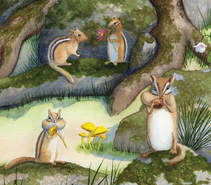
Chipmunks are cute, noisy little rodents that can stash around eight pounds of food in their nests for the winter. They have a pocket in each cheek that serves as a big grocery sack. These pockets, or pouches, can each stretch to be as big as their whole body - or about three times as big as their heads - when packed! They mostly sleep during the winter, but wake up several times to eat from their supply.
No creature has been ignored by the God of Creation when it comes to unique, thrifty design!
No creature has been ignored by the God of Creation when it comes to unique, thrifty design!
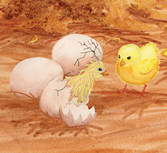
Which came first? The chicken or the egg?
This week we’ll look at chickens. Now that doesn’t sound very exciting - but just wait a minute. Look at their eggs (any birds egg for that matter). Ever wonder how the chick didn’t suffocate in there?
The shell of the egg has thousands of little pores in it. These let oxygen in, and carbon dioxide out at just the perfect rate so the chick doesn’t suffocate and can still grow.
You know that little air bubble at one end of the egg - the flat spot? That has the perfect amount of air in it so that – on the 19th day - when the chick does become too big for the oxygen supply it gets through the shell, it can peck into that air sack and have just enough oxygen - about 6 hrs worth - to peck a hole in the shell so it can breathe before it does suffocate. If it were a day early or a day late, it would not survive – That is an incredibly intelligent design! If any part of the eggs design were altered at all, the chick would not make it!
This week we’ll look at chickens. Now that doesn’t sound very exciting - but just wait a minute. Look at their eggs (any birds egg for that matter). Ever wonder how the chick didn’t suffocate in there?
The shell of the egg has thousands of little pores in it. These let oxygen in, and carbon dioxide out at just the perfect rate so the chick doesn’t suffocate and can still grow.
You know that little air bubble at one end of the egg - the flat spot? That has the perfect amount of air in it so that – on the 19th day - when the chick does become too big for the oxygen supply it gets through the shell, it can peck into that air sack and have just enough oxygen - about 6 hrs worth - to peck a hole in the shell so it can breathe before it does suffocate. If it were a day early or a day late, it would not survive – That is an incredibly intelligent design! If any part of the eggs design were altered at all, the chick would not make it!
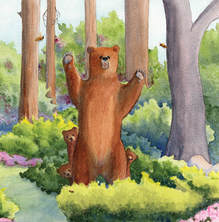
The Bear Facts:
Bears, as well as some other animals have this incredible process built into them called “Hibernation.”
In the fall, before the go into hibernation, bears gorge themselves, putting on around 30 pound a week! All that stored fat will enable them to survive the cold winter. (Bears are omnivorous, like us, and eat fruits, vegetables and meat.)
They prepare their den in caves, hollowed out trees, or burrows, just big enough for the bear and her cubs, if she has any, to fit into. They pad it with leaves and other plant materials and when the time is right, they climb in and snuggle up for the winter. Once they go to sleep they don’t move much at all. Their heart beat slows way down and can go as slow as 8 beats a minute! Their breathing and whole metabolism slows down with their body temperature dropping dramatically to conserve energy. They can sleep for up to 100 days without eating, drinking or any of the bodily processes that go along with that. Watch out when they wake up in the spring though – they’re pretty hungry by then.
Another wonderful example of God’s great wisdom and intelligent Design!
Bears, as well as some other animals have this incredible process built into them called “Hibernation.”
In the fall, before the go into hibernation, bears gorge themselves, putting on around 30 pound a week! All that stored fat will enable them to survive the cold winter. (Bears are omnivorous, like us, and eat fruits, vegetables and meat.)
They prepare their den in caves, hollowed out trees, or burrows, just big enough for the bear and her cubs, if she has any, to fit into. They pad it with leaves and other plant materials and when the time is right, they climb in and snuggle up for the winter. Once they go to sleep they don’t move much at all. Their heart beat slows way down and can go as slow as 8 beats a minute! Their breathing and whole metabolism slows down with their body temperature dropping dramatically to conserve energy. They can sleep for up to 100 days without eating, drinking or any of the bodily processes that go along with that. Watch out when they wake up in the spring though – they’re pretty hungry by then.
Another wonderful example of God’s great wisdom and intelligent Design!
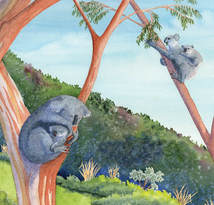
Koala Curiosities:
Koalas aren’t bears. They’re marsupials – meaning their young are born very tiny and under developed. The baby climbs into its mother’s pouch by its sense of smell (their eyes and ears aren’t developed yet) and it stays in there, nursing for 6 -7 months until they’re ready to come out.
Koalas only eat eucalyptus leaves which makes them smell like eucalyptus. They get their water from the leaves as well.
They have 3 fingers and 2 thumbs on their front paws. The hind paw has 2 of the toes grown together out to the end. This makes a great comb for their hair.
Another amazingly wise creation by an amazingly wise God!
Koalas aren’t bears. They’re marsupials – meaning their young are born very tiny and under developed. The baby climbs into its mother’s pouch by its sense of smell (their eyes and ears aren’t developed yet) and it stays in there, nursing for 6 -7 months until they’re ready to come out.
Koalas only eat eucalyptus leaves which makes them smell like eucalyptus. They get their water from the leaves as well.
They have 3 fingers and 2 thumbs on their front paws. The hind paw has 2 of the toes grown together out to the end. This makes a great comb for their hair.
Another amazingly wise creation by an amazingly wise God!
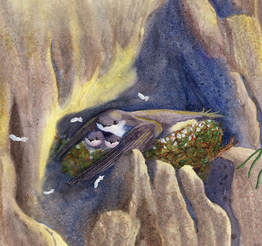
Swifts, Cliff Dweller:
Swifts are small birds that spend about nine months at a time on the wing – at around 10,000 feet altitude – rarely landing! They can eat, sleep, preen themselves, play, etc. in the air. These birds are seldom seen by people because they land only during nesting season, with few exceptions. They leave the nest at dusk to eat, while rearing their young, making a ball of 300 – 1,000 bugs in their mouths to feed their babies when they get back. These nests are made in vertical gaps in cliff walls, sometimes behind waterfalls. They make their nests with the natural material around them gluing it to the wall of the cliff with their saliva!
God's creation is never boring!
Swifts are small birds that spend about nine months at a time on the wing – at around 10,000 feet altitude – rarely landing! They can eat, sleep, preen themselves, play, etc. in the air. These birds are seldom seen by people because they land only during nesting season, with few exceptions. They leave the nest at dusk to eat, while rearing their young, making a ball of 300 – 1,000 bugs in their mouths to feed their babies when they get back. These nests are made in vertical gaps in cliff walls, sometimes behind waterfalls. They make their nests with the natural material around them gluing it to the wall of the cliff with their saliva!
God's creation is never boring!
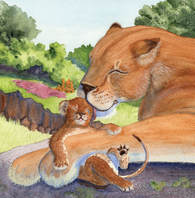
Lions like to lounge around and sleep for 16-20 hours a day. The male’s job is to keep watch while the female’s job is to do the hunting and care for their young. They may have 10 to 30 family members hanging out with them in their “pride.” Watch out when they get hungry! They hunt when it gets dark and work as a team to bring home dinner. A lion can run at 50 miles per hour for a short distance, then the next one picks up the chase like a relay, and they can leap up to 36 feet! Not so good for whatever they’re chasing.
In the process of feeding their “pride,” lions keep their local population of grazing animals in check.
Another one of God’s amazing and unique creatures ~
In the process of feeding their “pride,” lions keep their local population of grazing animals in check.
Another one of God’s amazing and unique creatures ~
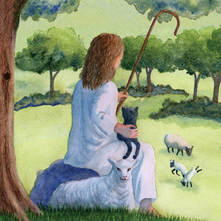
Sheep are creatures often used by the Lord to reveal our own character to us, so, with that in mind, let’s take a look at them.
They are pretty defenseless against those that would devour them, but, they're apparently not as dumb as I once thought. They can recognize up to 50 different sheep and people's faces for years and they know their masters face.
But they are just smart enough to be dangerous to themselves.
They are heard animals and will follow their heard anywhere - even over a cliff.
In 2005, 1,500 sheep in Turkey followed their leader to their death over a cliff!
Did your parents ever say to you, "If your friends jumped off a cliff, would you do the same?" regarding peer pressure? Well, they were worried about the sheep-like qualities in us that God refers to again and again in the scriptures. "All we, like sheep have gone astray, each of us has turned to our own way . . ." That's why He gave us a Shepherd.
All in all, sheep need their shepherd, and we need our Shepherd too!
Have a wonderful week!
They are pretty defenseless against those that would devour them, but, they're apparently not as dumb as I once thought. They can recognize up to 50 different sheep and people's faces for years and they know their masters face.
But they are just smart enough to be dangerous to themselves.
They are heard animals and will follow their heard anywhere - even over a cliff.
In 2005, 1,500 sheep in Turkey followed their leader to their death over a cliff!
Did your parents ever say to you, "If your friends jumped off a cliff, would you do the same?" regarding peer pressure? Well, they were worried about the sheep-like qualities in us that God refers to again and again in the scriptures. "All we, like sheep have gone astray, each of us has turned to our own way . . ." That's why He gave us a Shepherd.
All in all, sheep need their shepherd, and we need our Shepherd too!
Have a wonderful week!
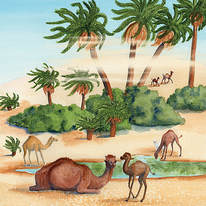
Camels are uniquely designed for life in the desert. They’ve been extremely useful to people for traveling across these large arid expanses throughout history. What are the unique design features camels have that enable them to do this?
Camels can drink up to 40 gallons of water at a time, but, it’s not stored in their humps – they store fat in their humps. The camels body transforms this fat into food and water as needed. Most creatures can only loose about 15% of their water content before they become dehydrated – a camel can loose up to 25%!
They have long eyelashes to shield their eyes from blowing sand, and their fur reflects the sun, helping to keep them cooler inside.
Camel’s nostrils are truly amazing in their design. They can close when there’s too much sand blowing around them. The inside of the nostrils is lined with tissue that absorbs water from the air as the camel exhales. This moisture is then recirculated back into the camel’s body for continued use! This process also works in reverse, using evaporative cooling to cool the camels core when it gets too hot – like sweating. Scientists have studied this design to help them with desalinization processes and retaining water for growing gardens in the deserts.
Camels can drink up to 40 gallons of water at a time, but, it’s not stored in their humps – they store fat in their humps. The camels body transforms this fat into food and water as needed. Most creatures can only loose about 15% of their water content before they become dehydrated – a camel can loose up to 25%!
They have long eyelashes to shield their eyes from blowing sand, and their fur reflects the sun, helping to keep them cooler inside.
Camel’s nostrils are truly amazing in their design. They can close when there’s too much sand blowing around them. The inside of the nostrils is lined with tissue that absorbs water from the air as the camel exhales. This moisture is then recirculated back into the camel’s body for continued use! This process also works in reverse, using evaporative cooling to cool the camels core when it gets too hot – like sweating. Scientists have studied this design to help them with desalinization processes and retaining water for growing gardens in the deserts.
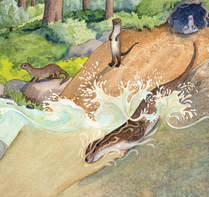
Otters are playful, water loving animals. They make their homes along rivers, streams and lakes with easy access to the water – using rocks and brush for shelter and protection. They’re designed for easy maneuverability in water, using their whole bodies to glide along – undulating up and down, paddling with their back feet and using their tail like a rudder. When swimming, otters can close their ears and nostrils to keep water out, and can dive down to 60 feet, holding their breath for 4 to 8 minutes at a time. They have thick, sleek fur coats to keep them warm. Their fur is also perfect for sliding into the water and doing belly-flops.
Otters are at home on land as well as in the water, but still like to slide along on their bellies whenever they can – run, run, slide, run, run, slide . . . Sometimes you can see their slippery sliding spots along the banks of a waterway. Snow is another perfect playground for otters.
They are carnivores, eating fish, frogs and other little critters, so they need healthy clean streams and waterways for their survival.
Another one of God’s amazing creations!
Otters are at home on land as well as in the water, but still like to slide along on their bellies whenever they can – run, run, slide, run, run, slide . . . Sometimes you can see their slippery sliding spots along the banks of a waterway. Snow is another perfect playground for otters.
They are carnivores, eating fish, frogs and other little critters, so they need healthy clean streams and waterways for their survival.
Another one of God’s amazing creations!
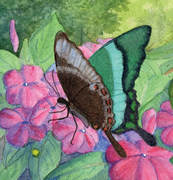
Blue Morpho Butterfly:
The beautiful wings of the Blue Morpho butterfly have long been sought after for jewelry and decorations. This butterflie's wingspan can be up to eight inches! The beautiful blue to green color on the upper surface of their wings flashes in the light as they fly, confusing their predators, while the brown patterned underside blends into their surroundings when they’re at rest with their wings closed, for protection – so they can hide. They like to warm themselves in the sun, and live high up in the treetops of the rain forests, flitting casually about. Using their long nose/mouth (proboscis) they drink the juices of rotting fruit and tree sap, smelling and tasting through their legs and antennae.
This butterfly has a fairly short lifespan of 137 days.
The Blue Morpho’s wing pigmentation reflects light in such a way as to change color according to the angle from which its viewed. This characteristic is being studied and mimicked for use on money and credit cards to make them counterfeit proof.
The beautiful wings of the Blue Morpho butterfly have long been sought after for jewelry and decorations. This butterflie's wingspan can be up to eight inches! The beautiful blue to green color on the upper surface of their wings flashes in the light as they fly, confusing their predators, while the brown patterned underside blends into their surroundings when they’re at rest with their wings closed, for protection – so they can hide. They like to warm themselves in the sun, and live high up in the treetops of the rain forests, flitting casually about. Using their long nose/mouth (proboscis) they drink the juices of rotting fruit and tree sap, smelling and tasting through their legs and antennae.
This butterfly has a fairly short lifespan of 137 days.
The Blue Morpho’s wing pigmentation reflects light in such a way as to change color according to the angle from which its viewed. This characteristic is being studied and mimicked for use on money and credit cards to make them counterfeit proof.
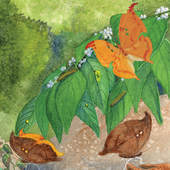
Leaf Wing butterflies have such amazing camouflage that only God could have thought of it! They look like decomposing leaves on the forest floor where they forage around for food. The spots that look like tattered holes in their wings are actually covered with a membrane so they can fly, which they do very well. They also have what looks like a mid-rib of a leaf running through their wings so perfectly it’s really hard to realize that it’s not a leaf.
It’s no surprise that Leaf Wings enjoy munching on the decaying matter with which they blend in so well. They are so confident in their camouflage that they don’t disturb easily.
God loves variety!
It’s no surprise that Leaf Wings enjoy munching on the decaying matter with which they blend in so well. They are so confident in their camouflage that they don’t disturb easily.
God loves variety!
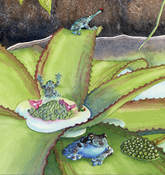
Milk Frogs:
The Milk frog, or Mission Golden-Eyed tree frog, lives its whole life in the Amazon rain Forest, up in the tree branches above water (perhaps for extra humidity, perhaps for safety if they fall). They can produce a poisonous milky fluid through their skin, thus, they have no predators except - strangely enough - their own tadpoles.
The male stakes out a nice waterfilled cavity in a tree and sends out around 4.000 mating calls in one night. The female comes and lays around 2,000 eggs in the lair which he fertilizes. She then leaves them to their own devices. The eggs hatch by the next day and eat any debris in their little home. When the tadpoles have consumed everything available, the male frog again calls for a female. This time he doesn’t fertilize the eggs but uses them as food for his little ones! He continues to do this until the tadpoles become frogs, which takes 3 - 4 weeks. These frogs have a high survival rate because they have no predators and there’s no current to wash them away.
Milk frogs have special pads on their toes for climbing trees that can hold up to 14 times their weight. They eat bugs and live up to 25 years.
The Milk frog, or Mission Golden-Eyed tree frog, lives its whole life in the Amazon rain Forest, up in the tree branches above water (perhaps for extra humidity, perhaps for safety if they fall). They can produce a poisonous milky fluid through their skin, thus, they have no predators except - strangely enough - their own tadpoles.
The male stakes out a nice waterfilled cavity in a tree and sends out around 4.000 mating calls in one night. The female comes and lays around 2,000 eggs in the lair which he fertilizes. She then leaves them to their own devices. The eggs hatch by the next day and eat any debris in their little home. When the tadpoles have consumed everything available, the male frog again calls for a female. This time he doesn’t fertilize the eggs but uses them as food for his little ones! He continues to do this until the tadpoles become frogs, which takes 3 - 4 weeks. These frogs have a high survival rate because they have no predators and there’s no current to wash them away.
Milk frogs have special pads on their toes for climbing trees that can hold up to 14 times their weight. They eat bugs and live up to 25 years.
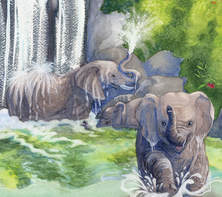
Elephants:
There are many aspects of the elephant worthy of mention - like the fact that they’re the largest land animal in the world and live in herds lead by the eldest female. But, today we’ll be looking at their incredible trunks.
An elephants upper lip and nose fuse together to create a trunk composed of more than 40,000 muscles. There are no bones in the trunk - it works with a system similar to hydraulics. This trunk can hoist 770 lbs. and reach branches 20 feet in the air. The African elephant's trunk has two finger-like protrusions with which they can pick up a blade of grass. They can hold 2 gallons of water at a time in their trunks and spray it into their mouths to drink, or up into the air to cool down, or, they can spray dust for a dust bath. They also use their trunks like snorkels when swimming.
Strong, yet sensitive, these trunks have an incredible sense of smell – four times better than a blood hound – and can sense vibrations in the ground - like distant herds or thunder storms. They use these trunks for expressing care and concern for other herd members, caressing and comforting each other.
God must have had fun creating the elephants!
There are many aspects of the elephant worthy of mention - like the fact that they’re the largest land animal in the world and live in herds lead by the eldest female. But, today we’ll be looking at their incredible trunks.
An elephants upper lip and nose fuse together to create a trunk composed of more than 40,000 muscles. There are no bones in the trunk - it works with a system similar to hydraulics. This trunk can hoist 770 lbs. and reach branches 20 feet in the air. The African elephant's trunk has two finger-like protrusions with which they can pick up a blade of grass. They can hold 2 gallons of water at a time in their trunks and spray it into their mouths to drink, or up into the air to cool down, or, they can spray dust for a dust bath. They also use their trunks like snorkels when swimming.
Strong, yet sensitive, these trunks have an incredible sense of smell – four times better than a blood hound – and can sense vibrations in the ground - like distant herds or thunder storms. They use these trunks for expressing care and concern for other herd members, caressing and comforting each other.
God must have had fun creating the elephants!
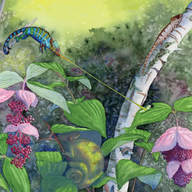
Chameleons:
God’s ingenuity was flowing freely when He created chameleons. There are 170 known species of these unusual, scaly little creatures, ranging from ½” to 27” in length. They can see all the way around themselves without turning their heads, because their eyes move independently from one another. You can tell when the males are moody because their skin changes color with different emotions, like anger or fear. They can also change color to blend in with their surroundings. Only the males do this. They have tiny light reflecting crystals in their skin that work by tensing or relaxing the upper layer of skin to change the cell arrangement – creating different colors. Most chameleons use their tails to help them travel through the trees and brush they call home. As loners, they live by themselves until mating season, at which point the brightest fellas win the ladies attention, but only briefly - then off they go on their own again. As chameleons grow they shed their skin in patches -not all at once like a snake.
It is the glory of God to conceal a matter, But the glory of kings is to search out a matter. Prov. 25:2
God’s ingenuity was flowing freely when He created chameleons. There are 170 known species of these unusual, scaly little creatures, ranging from ½” to 27” in length. They can see all the way around themselves without turning their heads, because their eyes move independently from one another. You can tell when the males are moody because their skin changes color with different emotions, like anger or fear. They can also change color to blend in with their surroundings. Only the males do this. They have tiny light reflecting crystals in their skin that work by tensing or relaxing the upper layer of skin to change the cell arrangement – creating different colors. Most chameleons use their tails to help them travel through the trees and brush they call home. As loners, they live by themselves until mating season, at which point the brightest fellas win the ladies attention, but only briefly - then off they go on their own again. As chameleons grow they shed their skin in patches -not all at once like a snake.
It is the glory of God to conceal a matter, But the glory of kings is to search out a matter. Prov. 25:2
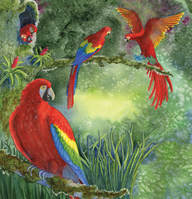
Macaw Parrots:
In their jungle homes, the Macaw’s brilliant feather colors and patterns fit right in with the bright fruits and flowers, creating a camouflage effect. They’re well equipped for jungle life with long toes and sharp claws. The first and last toes oppose each others, sort of like our thumbs, making them perfect for gripping food and climbing branches. Their powerful hooked beaks are designed for breaking nuts and seeds open – even coconuts – and tearing off bites of food, as well as aiding with climbing.
Macaws are very social and live in family units. These intelligent birds communicate with very loud squawks and calls, and they can mimic human speech! It’s been observed that the parents address each baby bird with a call specific to that bird – like a name! The oldest can be 100 years old.
To help these large, somewhat heavy birds fly, God gave them light bones, keeping their weight down. They can have a 4-foot wingspan.
This is God having fun!
In their jungle homes, the Macaw’s brilliant feather colors and patterns fit right in with the bright fruits and flowers, creating a camouflage effect. They’re well equipped for jungle life with long toes and sharp claws. The first and last toes oppose each others, sort of like our thumbs, making them perfect for gripping food and climbing branches. Their powerful hooked beaks are designed for breaking nuts and seeds open – even coconuts – and tearing off bites of food, as well as aiding with climbing.
Macaws are very social and live in family units. These intelligent birds communicate with very loud squawks and calls, and they can mimic human speech! It’s been observed that the parents address each baby bird with a call specific to that bird – like a name! The oldest can be 100 years old.
To help these large, somewhat heavy birds fly, God gave them light bones, keeping their weight down. They can have a 4-foot wingspan.
This is God having fun!
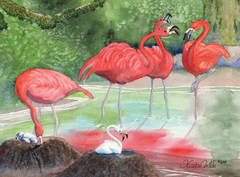
Flamingos:
These large wading birds like to live in relatively warm areas. They often stand on one foot with the other is tucked up into their feathers for warmth. Their very long stick-like legs and large webbed feet are wonderful for running on the surface of the water before takeoff.
A flamingo's pink feather color comes from its diet of shrimp, algae and little shell fish. The degree of color in their feathers depends on the amount of carotenoid (like carotene) in their diets. Babies are born white or gray and change color as the grow according to their diets. They’re also born with straight beaks that curve as they mature.
Adult Flamingos turn their heads upside down in the water for hours throughout the day and use their large upper bill like a scooper, filtering out their food.
They scoop up mud from the shallow water areas to make their nests, making a mound with a slight dip in the middle for their single egg, which both parents take turns sitting on.
Flamingoes are very loud birds and like a crowd – the largest colony is more than a million strong! Imagine the noise!
God has never been bored ~
These large wading birds like to live in relatively warm areas. They often stand on one foot with the other is tucked up into their feathers for warmth. Their very long stick-like legs and large webbed feet are wonderful for running on the surface of the water before takeoff.
A flamingo's pink feather color comes from its diet of shrimp, algae and little shell fish. The degree of color in their feathers depends on the amount of carotenoid (like carotene) in their diets. Babies are born white or gray and change color as the grow according to their diets. They’re also born with straight beaks that curve as they mature.
Adult Flamingos turn their heads upside down in the water for hours throughout the day and use their large upper bill like a scooper, filtering out their food.
They scoop up mud from the shallow water areas to make their nests, making a mound with a slight dip in the middle for their single egg, which both parents take turns sitting on.
Flamingoes are very loud birds and like a crowd – the largest colony is more than a million strong! Imagine the noise!
God has never been bored ~
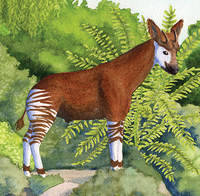
Okapi:
This unusual animal is native to a small part of the Congo rain forest of Africa.
While Okapi can make a squeaky kind of sound, they mostly communicate with sounds at so low a frequency their predators can’t hear them. Their stripes are zebra-like, but Okapis are more closely related to the giraffe. The males have skin-covered horns that protrude from just above their eyes and well below their ears on their forehead, which is rather unusual, and they can clean their eyes and ears with their 18” long tongue! This tongue is also handy for reaching high leaves and stripping them off the branches.
Baby Okapi hide in the same spot for 6 – 9 weeks while they grow and gain strength after birth.
Another of God’s wonderful – never boring creatures!
This unusual animal is native to a small part of the Congo rain forest of Africa.
While Okapi can make a squeaky kind of sound, they mostly communicate with sounds at so low a frequency their predators can’t hear them. Their stripes are zebra-like, but Okapis are more closely related to the giraffe. The males have skin-covered horns that protrude from just above their eyes and well below their ears on their forehead, which is rather unusual, and they can clean their eyes and ears with their 18” long tongue! This tongue is also handy for reaching high leaves and stripping them off the branches.
Baby Okapi hide in the same spot for 6 – 9 weeks while they grow and gain strength after birth.
Another of God’s wonderful – never boring creatures!
